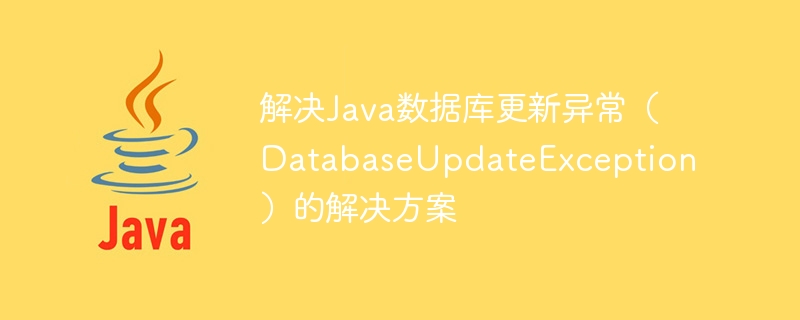

Solution to Java database update exception (DatabaseUpdateException)
When using Java programming language for database operations, we often encounter database update exception (DatabaseUpdateException) . This kind of exception is usually caused by improper data operation, database connection exception or SQL statement error. This article will introduce some common solutions to handle these exceptions, with corresponding code examples.
Before performing database operations, first ensure that the database connection is normal. If there is a problem with the database connection, an exception will be thrown when executing the SQL statement. You can check whether the database connection is normal by writing a simple method:
public class DatabaseUtil {
// ...
public static Connection getConnection() {
Connection conn = null;
try {
// 获取数据库连接代码
} catch (SQLException e) {
e.printStackTrace();
}
return conn;
}
public static boolean isConnectionValid(Connection conn) {
try {
return conn.isValid(5000); // 设置超时时间为5秒
} catch (SQLException e) {
e.printStackTrace();
}
return false;
}
} Before performing database operations, you can call the isConnectionValid method to check whether the database connection is valid.
Before executing the SQL statement, be sure to carefully check the correctness of the SQL statement. Common SQL statement errors include syntax errors, table name errors, field name errors, etc. You can check the correctness of the SQL statement by printing it or using database debugging tools.
public class DatabaseUtil {
// ...
public static void insertData(String name, int age) throws SQLException {
Connection conn = null;
Statement stmt = null;
try {
conn = getConnection();
stmt = conn.createStatement();
String sql = "INSERT INTO user (name, age) VALUES ('" + name + "', " + age + ")";
stmt.executeUpdate(sql);
} catch (SQLException e) {
e.printStackTrace();
throw e;
} finally {
// 释放资源的代码
}
}
}When performing the data insertion operation, you can first print the SQL statement to see if it meets expectations.
If an exception is thrown during the database update operation, corresponding exception handling should be performed. You can choose to capture and record exceptions, roll back transactions, or close database connections based on specific circumstances.
public class DatabaseUtil {
// ...
public static void updateData(int id, String name) {
Connection conn = null;
Statement stmt = null;
try {
conn = getConnection();
stmt = conn.createStatement();
String sql = "UPDATE user SET name='" + name + "' WHERE id=" + id;
stmt.executeUpdate(sql);
} catch (SQLException e) {
e.printStackTrace();
// 异常处理代码
} finally {
// 释放资源的代码
}
}
}When updating data, if an exception occurs, corresponding processing can be carried out according to the actual situation, such as logging or rolling back the transaction.
When performing database operations, you can use transactions to ensure the atomicity of a set of operations. Transactions can guarantee that multiple database operations either all succeed or all fail. You can use the corresponding transaction management class to complete transaction control.
public class DatabaseUtil {
// ...
public static void updateDataWithTransaction(int id, String name) throws SQLException {
Connection conn = null;
Statement stmt = null;
try {
conn = getConnection();
conn.setAutoCommit(false);
stmt = conn.createStatement();
String sql = "UPDATE user SET name='" + name + "' WHERE id=" + id;
stmt.executeUpdate(sql);
// 其他数据库操作代码
conn.commit();
} catch (SQLException e) {
e.printStackTrace();
conn.rollback();
throw e;
} finally {
// 释放资源的代码
conn.setAutoCommit(true);
}
}
}When using transactions, you need to call the setAutoCommit(false) method in the appropriate place to set the automatic commit of the transaction to false, and call it after the transaction execution is completed commit() method commits the transaction. If an exception occurs, you can call the rollback() method to roll back the transaction and continue to throw the exception upward.
In summary, solving Java database update exceptions requires us to carefully check the database connection, SQL statements and perform appropriate exception handling. Reasonable use of transactions can ensure the atomicity of database operations. Through the above solutions and code examples, we hope to help readers better handle database update exceptions.
The above is the detailed content of Solution to solve Java database update exception (DatabaseUpdateException). For more information, please follow other related articles on the PHP Chinese website!
